How to remove Bee Hive browser hijacker
Browser HijackerAlso Known As: search.beehivetab.com redirect
Get free scan and check if your device is infected.
Remove it nowTo use full-featured product, you have to purchase a license for Combo Cleaner. Seven days free trial available. Combo Cleaner is owned and operated by RCS LT, the parent company of PCRisk.com.
What kind of application is Bee Hive?
During our evaluation of the Bee Hive app, we identified it as a browser hijacker. Bee Hive is structured to alter specific browser settings to promote a deceptive search engine, and it may also encompass additional features. It is worth noting that most browser hijackers are promoted as useful browser extensions.
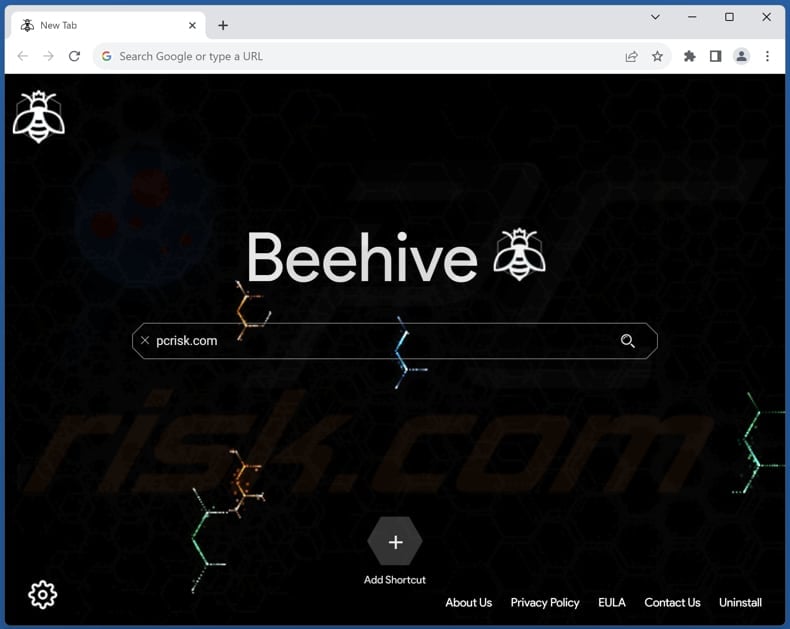
Bee Hive browser hijacker overview
Bee Hive conducts browser hijacking by modifying the default search engine, homepage, and new tab page settings to redirect users to search.beehivetab.com, a deceptive search engine. This fake engine does not provide genuine search results. It redirects users to bing.com, a legitimate search engine.
Users should exercise caution and avoid placing their trust in fake search engines for compelling reasons. These deceptive search engines often operate with dishonest or harmful intentions, presenting substantial threats to user privacy and security. They may surreptitiously gather sensitive data without consent, escalating the risk of identity theft and privacy breaches.
Furthermore, these deceptive search engines possess the ability to present altered or falsified search results, which can potentially direct users to unsafe websites, some of which may contain malicious software or endorse fraudulent activities. As a result, search.beehivetab.com should not be considered trustworthy and should be promptly removed from the settings of a hijacked browser.
In order to guarantee a safe and dependable online experience, it is crucial for users to depend on reputable and well-established search engines like Google or Bing that prioritize user safety and offer precise and unbiased search results. Additionally, users should eliminate any browser extensions like Bee Hive to enhance their browsing security.
| Name | Bee Hive |
| Threat Type | Browser Hijacker, Redirect, Search Hijacker, Toolbar, Unwanted New Tab |
| Browser Extension(s) | Bee Hive |
| Supposed Functionality | Improved browsing experience |
| Promoted URL | search.beehivetab.com |
| Detection Names (search.beehivetab.com) | N/A (VirusTotal) |
| Serving IP Address (search.beehivetab.com) | 3.225.140.174 |
| Affected Browser Settings | Homepage, new tab URL, default search engine |
| Symptoms | Manipulated Internet browser settings (homepage, default Internet search engine, new tab settings). Users are forced to visit the hijacker's website and search the Internet using their search engines. |
| Distribution methods | Deceptive pop-up ads, free software installers (bundling), fake Flash Player installers. |
| Damage | Internet browser tracking (potential privacy issues), display of unwanted ads, redirects to dubious websites. |
| Malware Removal (Windows) |
To eliminate possible malware infections, scan your computer with legitimate antivirus software. Our security researchers recommend using Combo Cleaner. Download Combo CleanerTo use full-featured product, you have to purchase a license for Combo Cleaner. 7 days free trial available. Combo Cleaner is owned and operated by RCS LT, the parent company of PCRisk.com. |
Browser hijackers in general
Browser hijackers are unwanted apps that modify browser settings such as the homepage, default search engine, and new tab page. They redirect users to shady websites (mostly fake search engines), disrupting the browsing experience and potentially exposing users to harmful or deceptive online content.
Browser hijackers not only compromise user privacy but pose a nuisance and a potential security threat, compelling users to be cautious and promptly remove these unwanted intruders to ensure a secure and uninterrupted browsing experience.
Examples of apps designed to function as browser hijackers are Quick Newtab, Dark Home, and Art New tabs.
How did Bee Hive install on my computer?
Users frequently unknowingly introduce browser hijackers into their systems, often as a result of software bundling where additional programs are included alongside downloads and can easily be overlooked during the installation process. Deceptive tactics, such as misleading advertisements or counterfeit download buttons, can also lead users to acquire or install browser hijackers.
In other cases, users download browser hijackers via unreliable notifications from shady pages, third-party downloaders, torrent sites, P2P networks, etc.
How to avoid installation of browser hijackers?
Choose custom or advanced installation settings whenever possible to thoroughly examine bundled software and unselect any additional programs that are unnecessary. Refrain from clicking on dubious advertisements and pop-ups, as they frequently direct users to deceptive websites that can initiate browser hijacking. Maintain up-to-date operating systems and web browsers.
Lastly, exercise prudence when downloading browser extensions or add-ons, opting to install or add only those from reputable sources such as official pages or trusted app stores. If your computer is already infected with Bee Hive, we recommend running a scan with Combo Cleaner Antivirus for Windows to automatically eliminate this browser hijacker.
Search.beehivetab.com redirects users to bing.com (GIF):
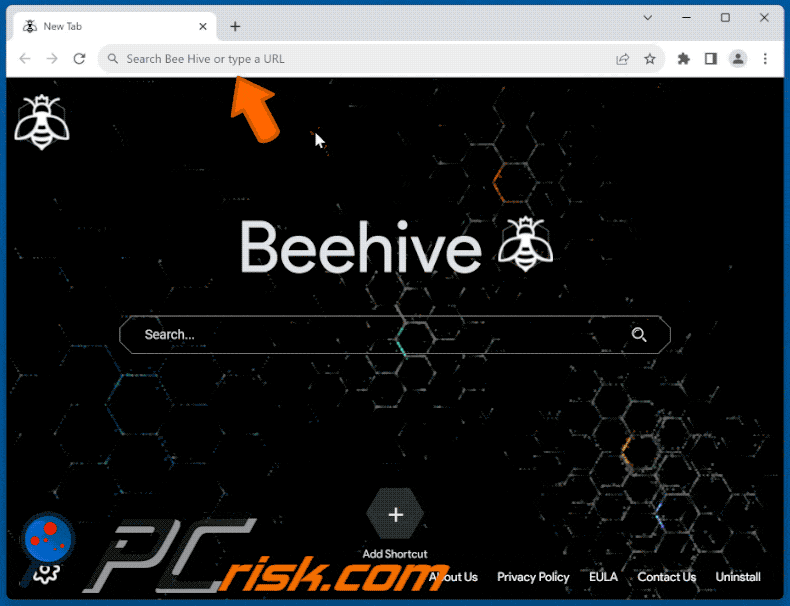
Permissions asked by Bee Hive browser hijacker:
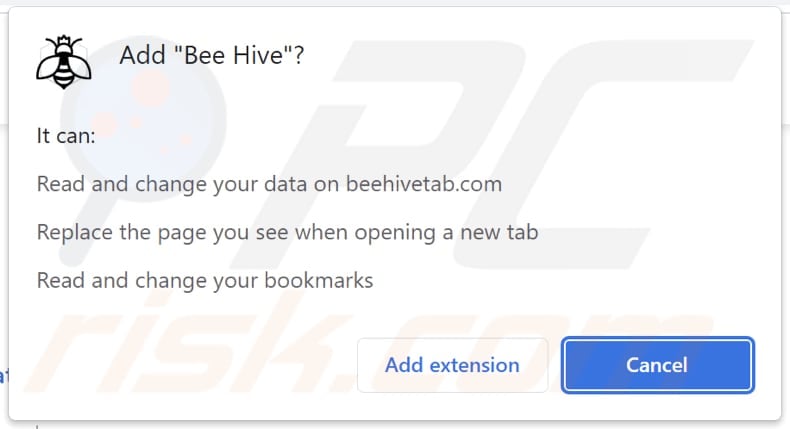
Website promoting Bee Hive browser hijacker:

Instant automatic malware removal:
Manual threat removal might be a lengthy and complicated process that requires advanced IT skills. Combo Cleaner is a professional automatic malware removal tool that is recommended to get rid of malware. Download it by clicking the button below:
DOWNLOAD Combo CleanerBy downloading any software listed on this website you agree to our Privacy Policy and Terms of Use. To use full-featured product, you have to purchase a license for Combo Cleaner. 7 days free trial available. Combo Cleaner is owned and operated by RCS LT, the parent company of PCRisk.com.
Quick menu:
- What is Bee Hive?
- STEP 1. Uninstall Bee Hive application using Control Panel.
- STEP 2. Remove Bee Hive browser hijacker from Google Chrome.
- STEP 3. Remove search.beehivetab.com homepage and default search engine from Mozilla Firefox.
- STEP 4. Remove search.beehivetab.com redirect from Safari.
- STEP 5. Remove rogue plug-ins from Microsoft Edge.
Bee Hive browser hijacker removal:
Windows 11 users:

Right-click on the Start icon, select Apps and Features. In the opened window search for the application you want to uninstall, after locating it, click on the three vertical dots and select Uninstall.
Windows 10 users:

Right-click in the lower left corner of the screen, in the Quick Access Menu select Control Panel. In the opened window choose Programs and Features.
Windows 7 users:

Click Start (Windows Logo at the bottom left corner of your desktop), choose Control Panel. Locate Programs and click Uninstall a program.
macOS (OSX) users:

Click Finder, in the opened screen select Applications. Drag the app from the Applications folder to the Trash (located in your Dock), then right click the Trash icon and select Empty Trash.

In the uninstall programs window: look for any recently installed suspicious applications, select these entries and click "Uninstall" or "Remove".
After uninstalling the potentially unwanted applications (which cause browser redirects to the search.beehivetab.com website), scan your computer for any remaining unwanted components. To scan your computer, use recommended malware removal software.
DOWNLOAD remover for malware infections
Combo Cleaner checks if your computer is infected with malware. To use full-featured product, you have to purchase a license for Combo Cleaner. 7 days free trial available. Combo Cleaner is owned and operated by RCS LT, the parent company of PCRisk.com.
Bee Hive browser hijacker removal from Internet browsers:
Video showing how to remove Bee Hive browser hijacker using Combo Cleaner:
 Remove malicious extensions from Google Chrome:
Remove malicious extensions from Google Chrome:

Click the Chrome menu icon ![]() (at the top right corner of Google Chrome), select "Extensions" and click "Manage Extensions". Locate "Bee Hive" and other recently-installed suspicious extensions, select these entries and click "Remove".
(at the top right corner of Google Chrome), select "Extensions" and click "Manage Extensions". Locate "Bee Hive" and other recently-installed suspicious extensions, select these entries and click "Remove".
Change your homepage:

Click the Chrome menu icon ![]() (at the top right corner of Google Chrome), select "Settings". In the "On startup" section, disable "Bee Hive", look for a browser hijacker URL (hxxp://www.search.beehivetab.com) below the "Open a specific or set of pages" option. If present click on the three vertical dots icon and select "Remove".
(at the top right corner of Google Chrome), select "Settings". In the "On startup" section, disable "Bee Hive", look for a browser hijacker URL (hxxp://www.search.beehivetab.com) below the "Open a specific or set of pages" option. If present click on the three vertical dots icon and select "Remove".
Change your default search engine:

To change your default search engine in Google Chrome: Click the Chrome menu icon ![]() (at the top right corner of Google Chrome), select "Settings", in the "Search engine" section, click "Manage search engines...", in the opened list look for "search.beehivetab.com", when located click the three vertical dots near this URL and select "Delete".
(at the top right corner of Google Chrome), select "Settings", in the "Search engine" section, click "Manage search engines...", in the opened list look for "search.beehivetab.com", when located click the three vertical dots near this URL and select "Delete".
- If you continue to have problems with browser redirects and unwanted advertisements - Reset Google Chrome.
Optional method:
If you continue to have problems with removal of the search.beehivetab.com redirect, reset your Google Chrome browser settings. Click the Chrome menu icon ![]() (at the top right corner of Google Chrome) and select Settings. Scroll down to the bottom of the screen. Click the Advanced… link.
(at the top right corner of Google Chrome) and select Settings. Scroll down to the bottom of the screen. Click the Advanced… link.

After scrolling to the bottom of the screen, click the Reset (Restore settings to their original defaults) button.

In the opened window, confirm that you wish to reset Google Chrome settings to default by clicking the Reset button.

 Remove malicious extensions from Mozilla Firefox:
Remove malicious extensions from Mozilla Firefox:
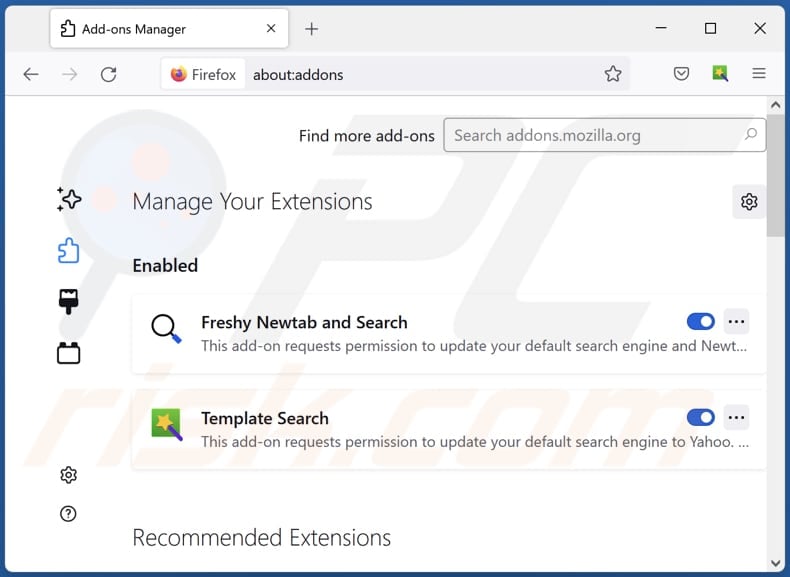
Click the Firefox menu ![]() (at the top right corner of the main window), select "Add-ons and themes". Click "Extensions", in the opened window locate "Bee Hive", as well as all recently-installed suspicious extensions, click on the three dots and then click "Remove".
(at the top right corner of the main window), select "Add-ons and themes". Click "Extensions", in the opened window locate "Bee Hive", as well as all recently-installed suspicious extensions, click on the three dots and then click "Remove".
Change your homepage:
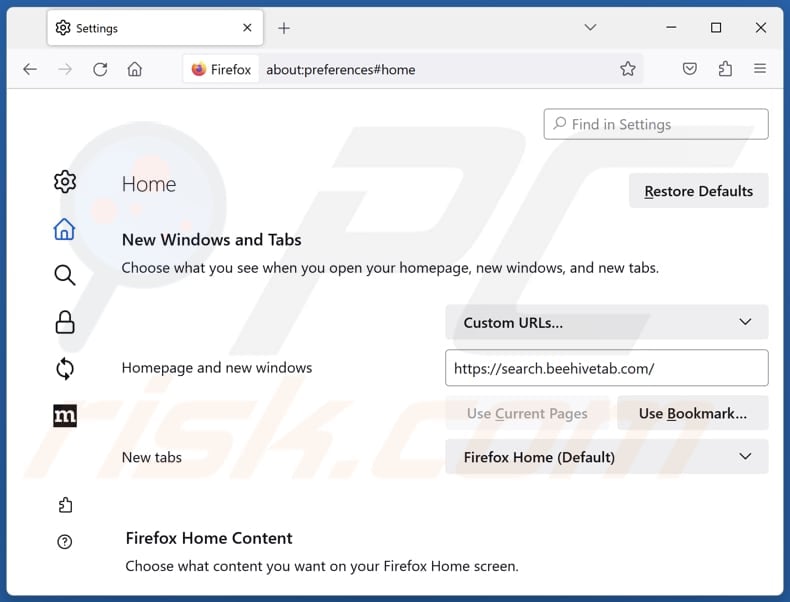
To reset your homepage, click the Firefox menu ![]() (at the top right corner of the main window), then select "Settings", in the opened window disable "Bee Hive", remove hxxp://search.beehivetab.com and enter your preferred domain, which will open each time you start Mozilla Firefox.
(at the top right corner of the main window), then select "Settings", in the opened window disable "Bee Hive", remove hxxp://search.beehivetab.com and enter your preferred domain, which will open each time you start Mozilla Firefox.
Change your default search engine:
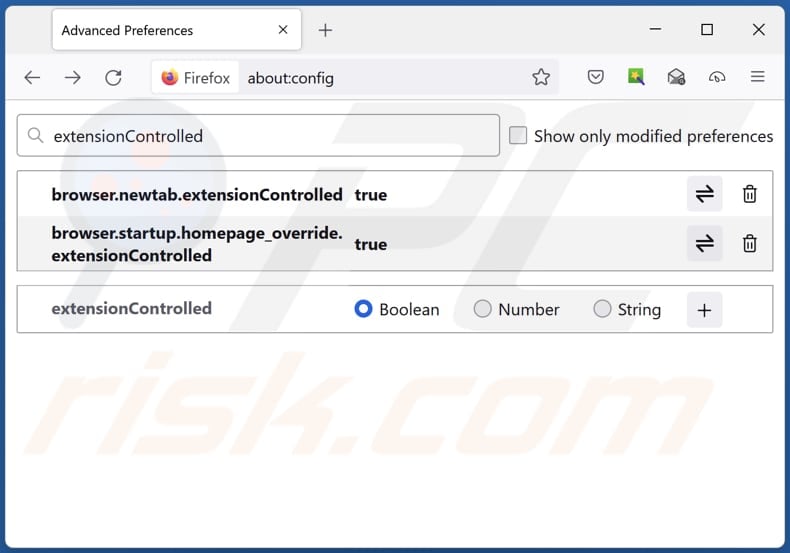
In the URL address bar, type "about:config" and press Enter. Click "Accept the Risk and Continue".
In the search filter at the top, type: "extensionControlled". Set both results to "false" by either double-clicking each entry or clicking the ![]() button.
button.
Optional method:
Computer users who have problems with search.beehivetab.com redirect removal can reset their Mozilla Firefox settings.
Open Mozilla Firefox, at the top right corner of the main window, click the Firefox menu, ![]() in the opened menu, click Help.
in the opened menu, click Help.

Select Troubleshooting Information.

In the opened window, click the Refresh Firefox button.

In the opened window, confirm that you wish to reset Mozilla Firefox settings to default by clicking the Refresh Firefox button.

 Remove malicious extensions from Safari:
Remove malicious extensions from Safari:

Make sure your Safari browser is active and click Safari menu, then select Preferences...

In the preferences window select the Extensions tab. Look for any recently installed suspicious extensions and uninstall them.

In the preferences window select General tab and make sure that your homepage is set to a preferred URL, if its altered by a browser hijacker - change it.

In the preferences window select Search tab and make sure that your preferred Internet search engine is selected.
Optional method:
Make sure your Safari browser is active and click on Safari menu. From the drop down menu select Clear History and Website Data...

In the opened window select all history and click the Clear History button.

 Remove malicious extensions from Microsoft Edge:
Remove malicious extensions from Microsoft Edge:

Click the Edge menu icon ![]() (at the top right corner of Microsoft Edge), select "Extensions". Locate any recently-installed suspicious browser add-ons, and remove them.
(at the top right corner of Microsoft Edge), select "Extensions". Locate any recently-installed suspicious browser add-ons, and remove them.
Change your homepage and new tab settings:

Click the Edge menu icon ![]() (at the top right corner of Microsoft Edge), select "Settings". In the "On startup" section look for the name of the browser hijacker and click "Disable".
(at the top right corner of Microsoft Edge), select "Settings". In the "On startup" section look for the name of the browser hijacker and click "Disable".
Change your default Internet search engine:

To change your default search engine in Microsoft Edge: Click the Edge menu icon ![]() (at the top right corner of Microsoft Edge), select "Privacy and services", scroll to bottom of the page and select "Address bar". In the "Search engines used in address bar" section look for the name of the unwanted Internet search engine, when located click the "Disable" button near it. Alternatively you can click on "Manage search engines", in the opened menu look for unwanted Internet search engine. Click on the puzzle icon
(at the top right corner of Microsoft Edge), select "Privacy and services", scroll to bottom of the page and select "Address bar". In the "Search engines used in address bar" section look for the name of the unwanted Internet search engine, when located click the "Disable" button near it. Alternatively you can click on "Manage search engines", in the opened menu look for unwanted Internet search engine. Click on the puzzle icon ![]() near it and select "Disable".
near it and select "Disable".
Optional method:
If you continue to have problems with removal of the search.beehivetab.com redirect, reset your Microsoft Edge browser settings. Click the Edge menu icon ![]() (at the top right corner of Microsoft Edge) and select Settings.
(at the top right corner of Microsoft Edge) and select Settings.

In the opened settings menu select Reset settings.

Select Restore settings to their default values. In the opened window, confirm that you wish to reset Microsoft Edge settings to default by clicking the Reset button.

- If this did not help, follow these alternative instructions explaining how to reset the Microsoft Edge browser.
Summary:
 A browser hijacker is a type of adware infection that modifies Internet browser settings by assigning the homepage and default Internet search engine settings to some other (unwanted) website URL. Commonly, this type of adware infiltrates operating systems through free software downloads. If your download is managed by a download client, ensure that you decline offers to install advertised toolbars or applications that seek to change your homepage and default Internet search engine settings.
A browser hijacker is a type of adware infection that modifies Internet browser settings by assigning the homepage and default Internet search engine settings to some other (unwanted) website URL. Commonly, this type of adware infiltrates operating systems through free software downloads. If your download is managed by a download client, ensure that you decline offers to install advertised toolbars or applications that seek to change your homepage and default Internet search engine settings.
Post a comment:
If you have additional information on search.beehivetab.com redirect or it's removal please share your knowledge in the comments section below.
Frequently Asked Questions (FAQ)
What is the purpose of forcing users visit search.beehivetab.com website?
The main objective behind this enforced redirection is to increase traffic to search.beehivetab.com, potentially generating revenue through ad clicks and collecting user data in the process.
Is visiting search.beehivetab.com a threat to my privacy?
Visiting search.beehivetab.com could pose a potential threat to your privacy, particularly if this fake search engine collects user data without consent or redirects you to other websites that do.
How did a browser hijacker infiltrate my computer?
A browser hijacker might have entered your computer through multiple avenues, often through software bundling, where it is included in packages with software installations. Inadvertent browser hijacker installation can also occur when users click deceptive advertisements, counterfeit download buttons, or visit questionable websites.
Will Combo Cleaner help me remove Bee Hive browser hijacker?
Combo Cleaner conducts computer scans to eliminate all browser-hijacking applications. Manual removal can be challenging, especially when multiple hijackers are present and can reinstall each other. In such instances, it becomes necessary to remove all browser hijackers simultaneously.
Share:

Tomas Meskauskas
Expert security researcher, professional malware analyst
I am passionate about computer security and technology. I have an experience of over 10 years working in various companies related to computer technical issue solving and Internet security. I have been working as an author and editor for pcrisk.com since 2010. Follow me on Twitter and LinkedIn to stay informed about the latest online security threats.
PCrisk security portal is brought by a company RCS LT.
Joined forces of security researchers help educate computer users about the latest online security threats. More information about the company RCS LT.
Our malware removal guides are free. However, if you want to support us you can send us a donation.
DonatePCrisk security portal is brought by a company RCS LT.
Joined forces of security researchers help educate computer users about the latest online security threats. More information about the company RCS LT.
Our malware removal guides are free. However, if you want to support us you can send us a donation.
Donate
▼ Show Discussion